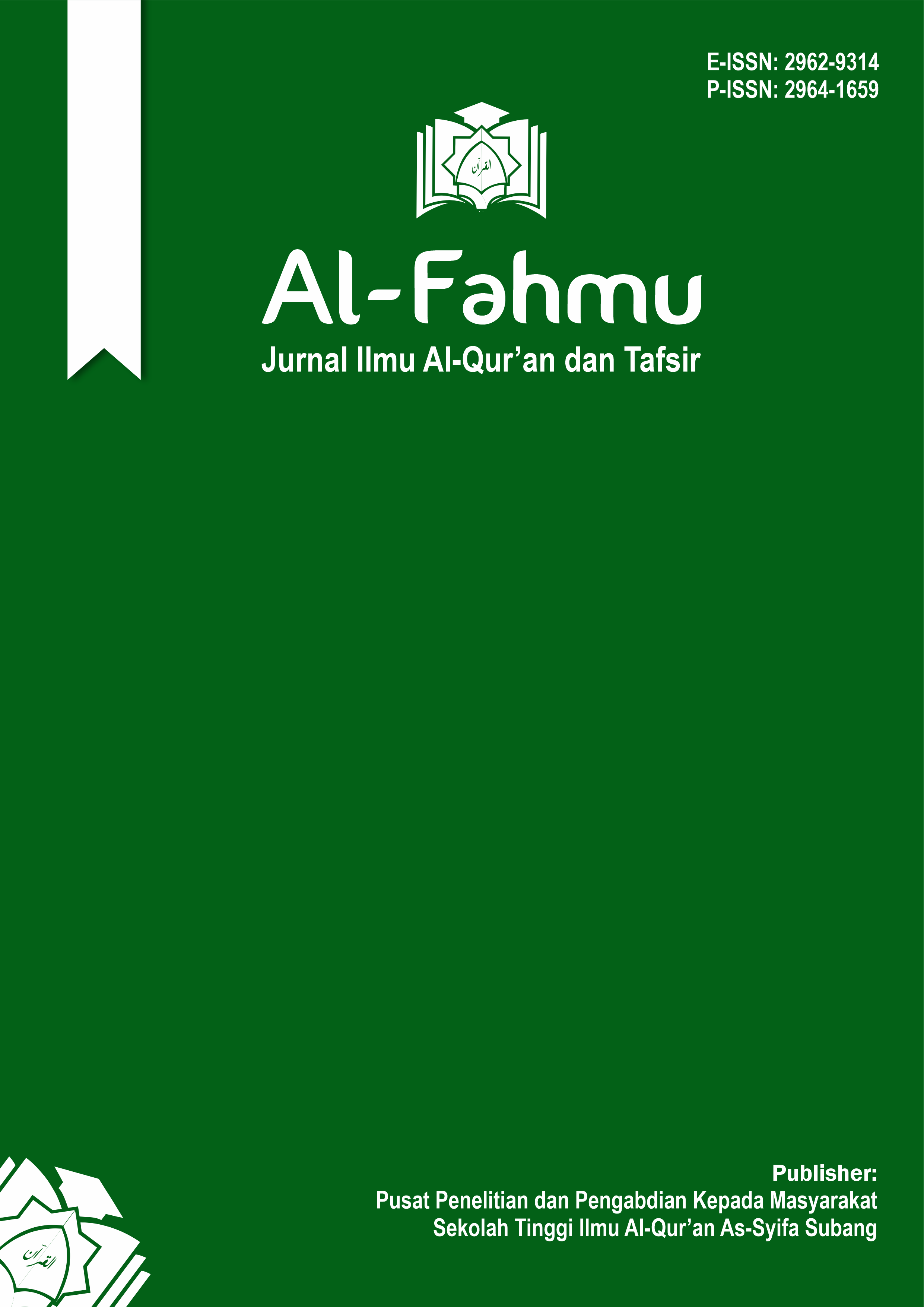Main Article Content
Abstract
This study will examine how dhikr is implemented in daily life by members of the Tabligh Jama'ah, especially in Radda Village, Baebunta District, North Luwu Regency, South Sulawesi. This type of research is field research, namely qualitative research using two approaches, namely the interpretation and sociology approaches. Furthermore, the data sources used are primary data sources through interviews with Tabligh Jama'ah figures and the community in Radda Village. Secondary data is auxiliary data obtained from literature such as journals, books, articles and tafsir books. Data processing and analysis techniques are data editing, data reduction and data presentation. The results of this study indicate that the influence of dhikr on individual members of the Tabligh Jama'ah is seen in inner peace, patience and awareness of closeness to Allah. Dhikr strengthens faith, directs behavior, and has a positive impact on social life, such as fostering brotherhood, caring and improving people's morals.
Keywords
Article Details

This work is licensed under a Creative Commons Attribution-NonCommercial-ShareAlike 4.0 International License.
References
- Abubakar, A., Ahmad, L. O. I., & Assegaf, Y. (2019). Ulumul Qur’an: Pisau Analisis Dalam Menafsirkan Al-Qur’an. Semesta Aksara.
- Al-Kandhahlawi, M. M. Z. (2011). Himpunan Kitab Fadhilah Amal. Pustaka Ramadhan.
- Al-Kumais, M. bin ‘Abd al-R. (n.d.). Zikr al-Jama’i bain al-Ibtida’i, terj. Abu Harkan, Zikir Bersama; Bid’ah atau Sunnah. Al-Tibyan.
- Al-Syaukānī, M. bin ‘Alī bin M. (2007). Fatḥ al-Qadīr. Dar Ma’rifah.
- Aman, S. (2015). Zikir Membangkitkan Kekuatan Bashirah. Penerbit Ruhama.
- Ensiklopedi Islam. (1996). PT Intermasa.
- Faris, A. H. A. I. (2001). Mu’jam Maqayis Al-Lugah. Daar Al-Ihya’ Al-Turats Al-’Arabi.
- Ghani, A. (2016). Membongkar Misteri Gerakan Sosial Islam (Studi Analisis Visi, Misi Dan Fenomenologis Komunitas Jamaah Tabligh). Jurnal Indo-Islamika, 6(1), 57. https://doi.org/10.15408/idi.v6i1.14795
- Harahap, N. (2020). Penelitian Kualitatif. Wal Ashri Publishing.
- Heddy Shri Ahimsa. (2012). the Living Al-Qur’an: Beberapa Perspektif Antropologi. Walisongo: Jurnal Penelitian Sosial Keagamaan, 20(1). 235–260. https://doi.org/10.21580/ws.20.1.198
- Husda, H. (2017). Jamaah Tabligh Cot Goh: Historis, Aktivitas dan Respon Masyarakat. Adabiya, 9(1), 35. https://doi.org/10.22373/adabiya.v19i1.7483
- Jabir, H. bin M. bin A. (1987). Menuju Jama’atul Muslimin. Rabbani Press.
- Kementerian Agama Republik Indonesia. (2019). Tentang Qur’an Kemenag In MS. Word.
- Kementrian Agama RI. (2019). Al-Qur’an dan Terjemahannya. Lajnah Pentashihan Mushaf AL-Qur’an.
- Misbah. (2007). Berzikir Cara Nabi: Merengkuh Puncak Zikir, Tahmid, Tasbih, Tahlil Dan Hauqalah. Mizan.
- Mufrodi, A. (2010). Islam di Kawasan Kebudayaan Arab. Aneka Bahagia.
- Munawwir, A. W. (2020). Kamus Al-Munawwir Arab-Indonesia (Edisi Keti). Pustaka Progressif.
- Razak, Y. (2008). Jama’ah tabligh ajaran dan dakwahnya. Universitas Islam Negeri Syarif Hidayatullah Jakarta.
- Salim, A. M., Mardan, & Abubakar, A. (2011). Metodologi Penelitian Tafsir Mauḍū’i. Pustaka al-Zikra.
- Sarwan, Franata, D., Sabiruddin, & Zainal. (2021). Sejarah Pemikiran dan Gerakan Dakwah Jama’ah Tabligh. Jurnal Al-Hikmah, 8(2), 34. https://doi.org/10.15548/al-hikmah.v8i2.3585
- Syarifuddin, U. (2017). , Paradigma Tafsir Tekstual & Kontekstual: Usaha Memaknai Kembali Pesan Al-Qur’an. Pustaka Belajar.
- Wijaya, A. (2020). Arah Baru Studi Ulumul Qur’an. IRCiSod.
- Yahya, A. bin. (2008). Mengenal Lebih Dekat Jamaah Tabligh. Pustaka Qabail.
- Zuḥailī, W. (2009). Al-Tafsīr Al-Munīr fī Al-’Aqīdah wa al-Syarī’ah wa Al-Manhaj. Dār al-Fikr.
References
Abubakar, A., Ahmad, L. O. I., & Assegaf, Y. (2019). Ulumul Qur’an: Pisau Analisis Dalam Menafsirkan Al-Qur’an. Semesta Aksara.
Al-Kandhahlawi, M. M. Z. (2011). Himpunan Kitab Fadhilah Amal. Pustaka Ramadhan.
Al-Kumais, M. bin ‘Abd al-R. (n.d.). Zikr al-Jama’i bain al-Ibtida’i, terj. Abu Harkan, Zikir Bersama; Bid’ah atau Sunnah. Al-Tibyan.
Al-Syaukānī, M. bin ‘Alī bin M. (2007). Fatḥ al-Qadīr. Dar Ma’rifah.
Aman, S. (2015). Zikir Membangkitkan Kekuatan Bashirah. Penerbit Ruhama.
Ensiklopedi Islam. (1996). PT Intermasa.
Faris, A. H. A. I. (2001). Mu’jam Maqayis Al-Lugah. Daar Al-Ihya’ Al-Turats Al-’Arabi.
Ghani, A. (2016). Membongkar Misteri Gerakan Sosial Islam (Studi Analisis Visi, Misi Dan Fenomenologis Komunitas Jamaah Tabligh). Jurnal Indo-Islamika, 6(1), 57. https://doi.org/10.15408/idi.v6i1.14795
Harahap, N. (2020). Penelitian Kualitatif. Wal Ashri Publishing.
Heddy Shri Ahimsa. (2012). the Living Al-Qur’an: Beberapa Perspektif Antropologi. Walisongo: Jurnal Penelitian Sosial Keagamaan, 20(1). 235–260. https://doi.org/10.21580/ws.20.1.198
Husda, H. (2017). Jamaah Tabligh Cot Goh: Historis, Aktivitas dan Respon Masyarakat. Adabiya, 9(1), 35. https://doi.org/10.22373/adabiya.v19i1.7483
Jabir, H. bin M. bin A. (1987). Menuju Jama’atul Muslimin. Rabbani Press.
Kementerian Agama Republik Indonesia. (2019). Tentang Qur’an Kemenag In MS. Word.
Kementrian Agama RI. (2019). Al-Qur’an dan Terjemahannya. Lajnah Pentashihan Mushaf AL-Qur’an.
Misbah. (2007). Berzikir Cara Nabi: Merengkuh Puncak Zikir, Tahmid, Tasbih, Tahlil Dan Hauqalah. Mizan.
Mufrodi, A. (2010). Islam di Kawasan Kebudayaan Arab. Aneka Bahagia.
Munawwir, A. W. (2020). Kamus Al-Munawwir Arab-Indonesia (Edisi Keti). Pustaka Progressif.
Razak, Y. (2008). Jama’ah tabligh ajaran dan dakwahnya. Universitas Islam Negeri Syarif Hidayatullah Jakarta.
Salim, A. M., Mardan, & Abubakar, A. (2011). Metodologi Penelitian Tafsir Mauḍū’i. Pustaka al-Zikra.
Sarwan, Franata, D., Sabiruddin, & Zainal. (2021). Sejarah Pemikiran dan Gerakan Dakwah Jama’ah Tabligh. Jurnal Al-Hikmah, 8(2), 34. https://doi.org/10.15548/al-hikmah.v8i2.3585
Syarifuddin, U. (2017). , Paradigma Tafsir Tekstual & Kontekstual: Usaha Memaknai Kembali Pesan Al-Qur’an. Pustaka Belajar.
Wijaya, A. (2020). Arah Baru Studi Ulumul Qur’an. IRCiSod.
Yahya, A. bin. (2008). Mengenal Lebih Dekat Jamaah Tabligh. Pustaka Qabail.
Zuḥailī, W. (2009). Al-Tafsīr Al-Munīr fī Al-’Aqīdah wa al-Syarī’ah wa Al-Manhaj. Dār al-Fikr.
